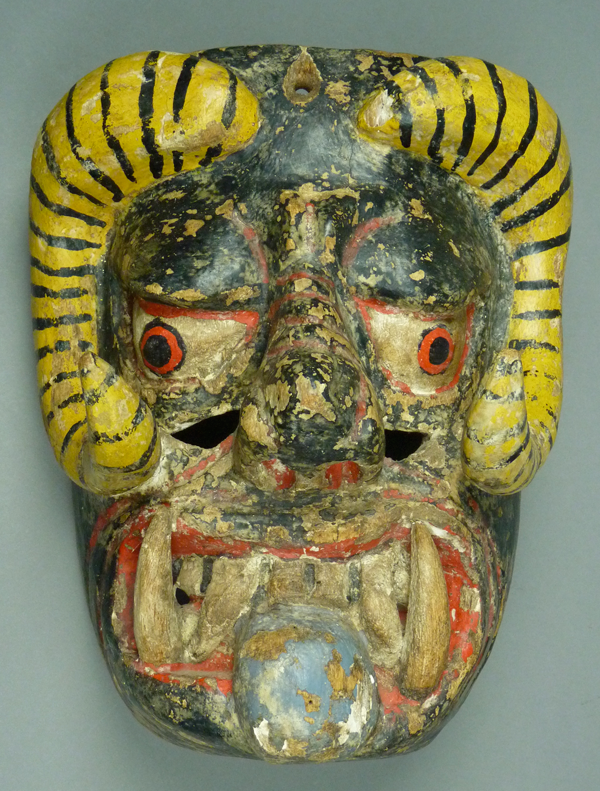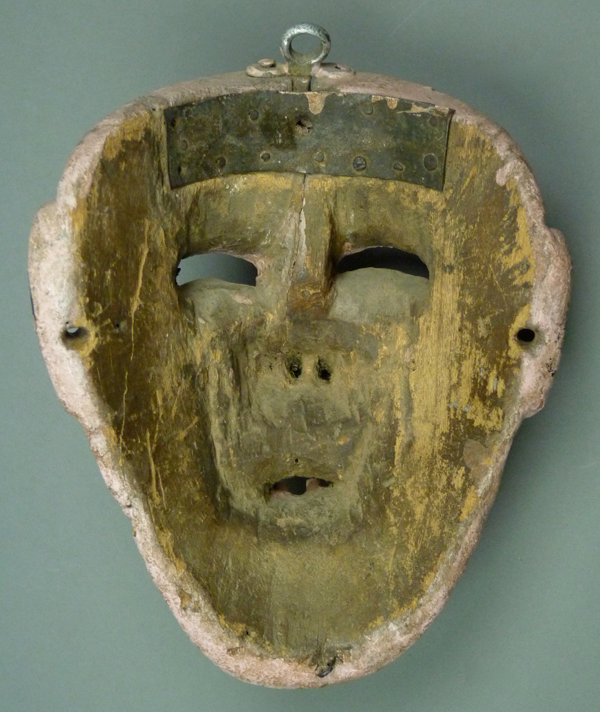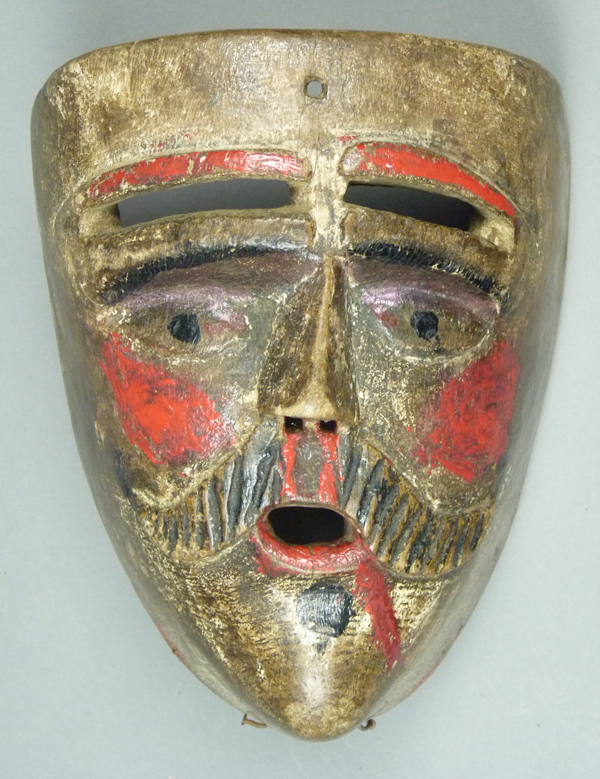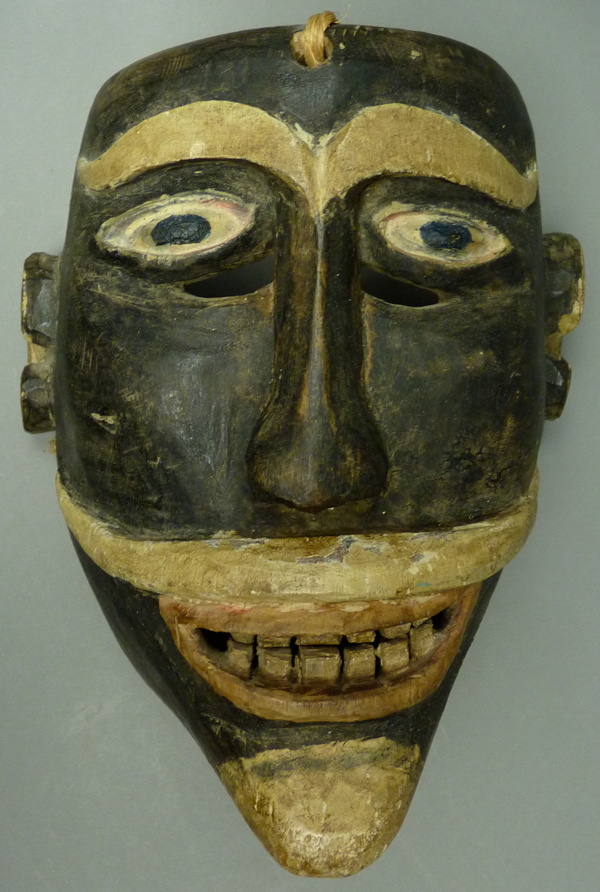This week I will shift to another subject—The Day of the Dead—inspired by a recent purchase on EBay. The seller, an online auction service, offered a set of five masks. These were obviously old and worn in appearance. Furthermore, they demonstrated numerous pinholes on their surfaces, as if they had been infested with wood boring insects, or they had been carved from wood that had been previously infested. Such masks can be very fragile, but these seemed to have normal strength, without obvious broken areas, except for a split out section on one of the ears of the Chivo, and a small broken area on the chin of the Calavera.
By now you may be wondering why anyone would buy such damaged goods. In fact, I had at least two reasons. To begin with, the carving of these masks was of very high quality, and there were several interesting designs. Masks of monkeys are very uncommon in the Mixtec towns, so their presence was of major importance, the skull mask was a masterpiece, the Viejo mask was superb, and the goat mask was also well carved. Therefore I was willing to gamble that they were not as fragile as they looked. Furthermore, each of the five masks had a small paper tag, in barely legible Spanish, that explained its role in “La Danza de los Muertos” (The Dance of the Dead). These tags were yellow with age. The information on the tags had evidently been copied from older labels that were pasted on the backs of each mask, but all that remained of the original labels were small corner fragments. No writing had survived on those scraps. It seemed possible to reconstruct the dance by translating and then combining the five descriptions from the tags, which seemed a remarkable opportunity to rescue an obviously old tradition from oblivion (salvage anthropology). The consigner had also provided the seller with limited further information. The masks had been collected in a small town in the Mixteca Alta of Oaxaca—Santa María Peñoles—in the 1930s or 1940s, and the last owner had purchased them from the original collector, in Mexico, in the late 70s. There had been additional masks in the group, with human faces.
For many centuries, the Mixtec Indians inhabited their own region in the present Mexican state of Oaxaca. The Mixteca, the territory of the Mixtecs, extends from the Costa Chica (little coast) of Oaxaca to the highland plateau of that state. It is customary to speak of the Mixteca as a region divided into two parts—the alta (highland) and the baja (lowland), which lies along the Pacific coast. Santa María Peñoles is a highland town that lies to the west of the city of Oaxaca.
Note that the correct pronunciation of Oaxaca is contrary to what many expect. One says “Wah-há-ka,” where each “a” has the same sound as that letter in “watch.” Think of Baja, California, as another model.
Here is an overview of the “Day of the Dead” celebration in Mexico. This appears to be a complicated story that has many unknown details, but there are some obvious starting points.
1. Prior to contact with Europeans, the Indians of Mexico already believed in an afterlife, and perceived death as a passage from one phase of life to another. They had burial rites, and they viewed the souls of the dead as potentially dangerous to the living, necessitating special funeral practices and precautions.
2. The Roman Catholic Europeans had their own beliefs and concerns about the dead. In particular, they celebrated the memory of the Christian Saints each year on November first, “All Saints,” and they remembered all of the remaining dead on November second, “All Souls Day.”
3. When the Spanish brought Christian missionaries to Mexico to convert the Indians, these two traditions were immediately blended, such that the European tradition was adopted, but yet indigenous elements crept in to alter its practice. This is an example of something that anthropologists call “syncretism,” in which a conqueror imposes a new religion, but elements of the native religion are somehow retained, usually covertly or in a disguised form.
4. In Mexico the terms “All Souls” and “All Saints” have merged into one, so that many Mexicans believe that the souls of most of the dead return each year to visit their living relatives for 24 hours on November first. This is an occasion of great joy for the living as they savor the belief that they are momentarily reunited with lost relatives. But then there are many local versions regarding the specific days when certain of the dead can be expected to visit. For example, those who were murdered or who died violent deaths may be expected on some other day or they may be perceived as unable to visit at this time of year. The souls of young children are often greeted during the 24 hours after November first.
5. In fact, All Souls is one of two times in the year when the souls of the dead may visit; the other occasion is at the time of Carnaval, the holiday that North Americans call “Mardi Gras” or “Shrove Tuesday.” There are regions in Mexico where there is apparently concern about possible visitations by the malevolent (or “unquiet”) dead, prompting the development of dances and related activities that are meant to mimic and thereby counteract such risks, and these can occur in November or during Carnaval. There were similar European traditions that have been reduced to our familiar Halloween activities.
With this background in place, we are ready to investigate the evidence for a very specific dance tradition from Santa María Peñoles, in the state of Oaxaca. I will present photographs of the five masks, including with each mask views of both sides of its paper label and my transcription of this. Then I will share my translation of the five labels. This will permit us to reconstruct this local version of the Dance of the Dead.
Here are the five masks ordered according to their numbered tags.
Mask #1—a large mask with a monkey’s face, the “Nahual Major.” Nahual (or Nagual, in Spanish g and h are often silent letters), which can mean sorcerer, is absent from many dictionaries, but Donald Cordy discussed this word and concept at length in Mexican Masks (e.g. page 174). He stated that nagual means “guardian spirit” and usually refers to an animal spirit that is part of a person’s soul. He also said that many Mexicans still believe in the concept that each person can have his or her own nagual, although now the word tonal is frequently substituted for nagual. Cordry believed that the Indians of Mexico had masks of naguales (plural form) and that the Spanish relabeled these as the masks of diablos. Major (pronounced “má-yor”) is an adjective that means lead, head, or chief.
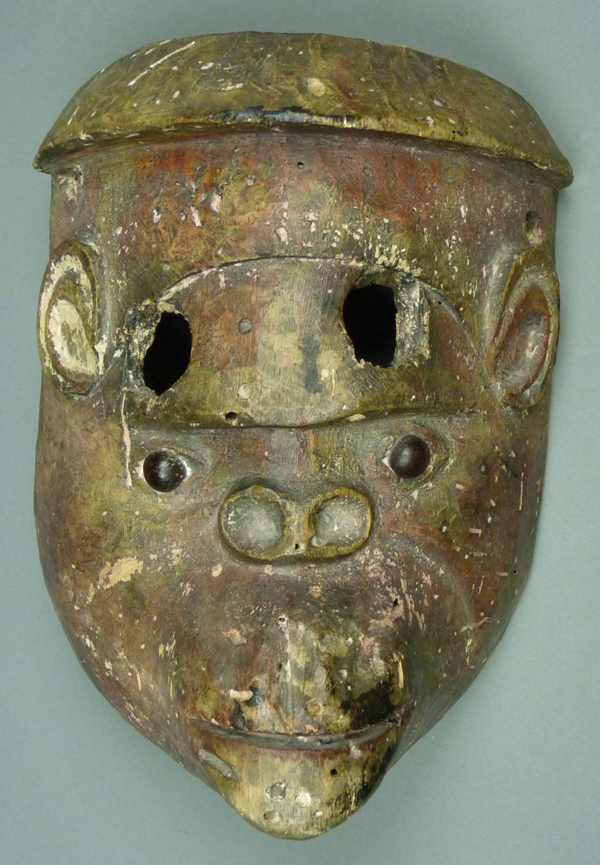
The Chango Major mask seen from the front. The vision slits almost seem like an afterthought. It measures 9″ x 6½” x 4″.
Continue Reading →

